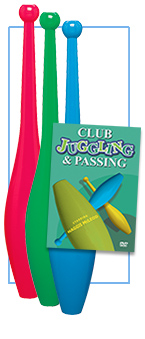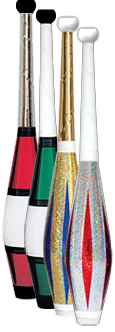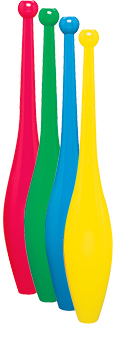ABOUT CLUBS
TERMINOLOGY: Many non-jugglers and newcomers to juggling use the phrase juggling pins. This is most likely due to their resemblance to bowling pins—but this is about as far as the connection goes. The fact that they are sometimes stood up, as in the photos on this website, further suggests the bowling metaphor. The term juggling clubs is derived from Indian clubs, from which they evolved. The phrase Indian Clubs is also sometimes used by non-jugglers looking for clubs—however, this term is not correct to describe clubs.
INDIAN CLUBS AND SWINGING Indian Clubs originated in India and were used for strength training. They were typically heavily weighted and used in pairs and swung in various patterns. They were not toss juggled. Club swinging has been revived and incorporated into the routines of many jugglers—some doing entire swinging routines, others using moves within their club juggling routines.
JUGGLING CLUBS
The first juggling clubs were fashioned from Indian clubs in the 1800s by juggler DeWitt Cook. At the turn of the century, Harry Lind and Ed Van Wyck made clubs entirely from wood in the style of the larger diameter Indian club.
EUROPEAN CLUBSIn Europe, clubs were of a thinner design either fabricated using bodies made from cork or bamboo struts covered in fabric. In either case, the main bodies of the clubs were slimmer than their American counterparts; hence the reason for the terms European versus American clubs.
MODERN CLUBSIn the 1960s, clubs made from plastic and wood were fabricated from plastic, wood and rubber. This construction, using numerous parts—primarily found objects—was developed by Jay Green of New York City. The modern juggling club was developed from this design by Brian Dubé in 1976 with a more durable, unified construction and the first production plastic molds. Other contemporary clubs are modeled after the Dubé/Green profile. Prior to this time the practice of juggling a linear object using rotations was done with juggling sticks and occasionally knives. Juggling sticks is another phrase that is typically avoided by jugglers, so as not to be confused with Devil Sticks.
Use the term juggling clubs and you will always be safe around jugglers.
Types of clubs and their use: We have a variety of clubs, suitable for different styles, jugglers and budgets. There are Unibody one piece clubs and multi-part composite clubs in different lengths and weights. Cost not considered, the Longhandled European Club 220 or 260 is the juggling club most popular around the world for over 33 years.











